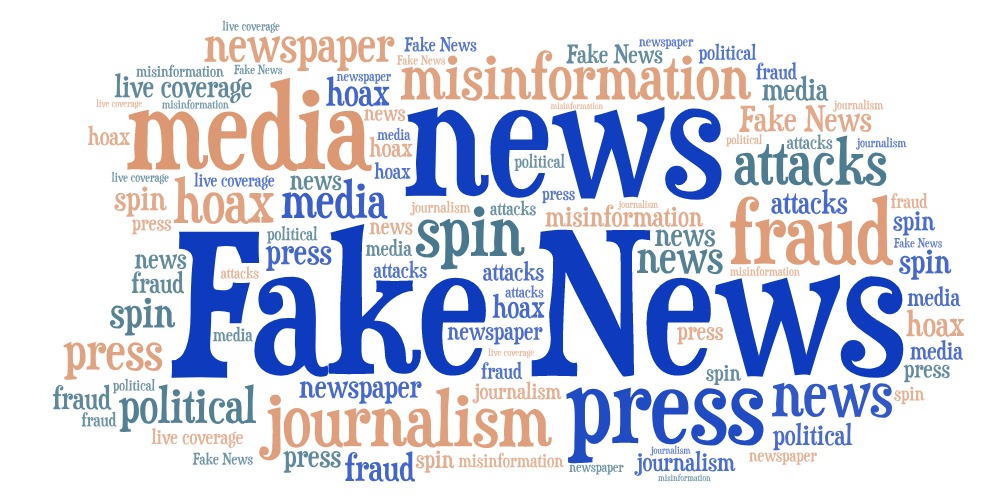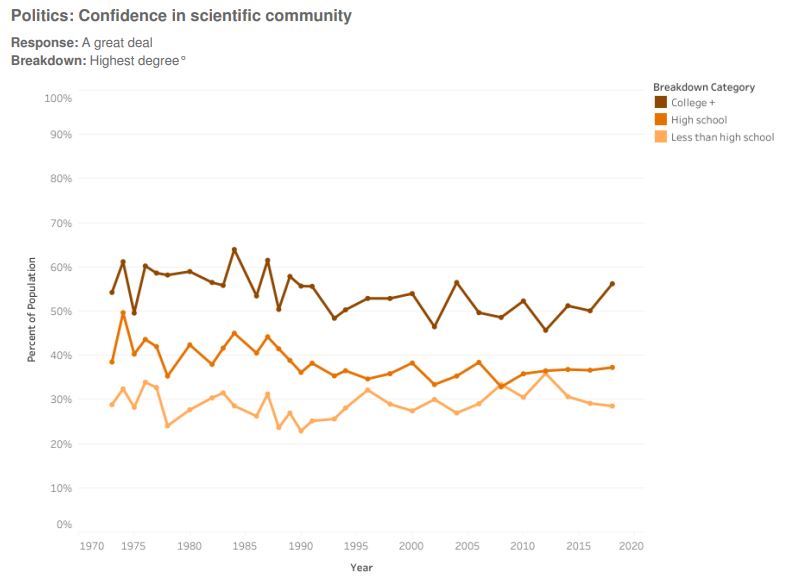
Over the last four years, there appears to have been a surge in the number of Americans who have lost their ability to make judgments based on factual information. If you’re on social media or follow news and politics, examples of people believing in misinformation, wild conspiracies or the outright denial of scientific principles seem to be at a fever pitch. Recent studies confirm that false and misleading information spreads far faster on Twitter and Facebook than the truth. MIT researchers offer several reasons why social media platforms are magnets for misinformation.
America’s move towards abandoning reality is concerning for obvious reasons. However, recent polling indicates that American confidence in science has actually remained steady since the 1970s.

The poll reveals knowledge gaps associated with level of education, but those gaps have been with us for decades. If American confidence in scientific principles has remained constant, why do we find so many people taking positions that are indefensible based on facts and evidence?
Social Media
Several circumstances arose over the last few years that help explain how misinformation percolates through society so easily. Social media is now an important tool for personal engagement for millions of people. Social media also serves as a significant source of news and information for a majority of U.S. adults. Recent interviews with technology and social media company executives have shown the extraordinary extent to which information is manipulated and controlled on digital platforms.
Note: Social media was initially used as a tool for socializing online. Digital information services were traditionally search engines that found answers to user queries. Recent innovations have blurred the line between the two terms. The two terms are used interchangeably in this article to capture the breadth of ways users may experience social and information gathering today.
The primary motive of digital information companies is to provide products that consumers like to use. Ad revenues and profits depend on the consumer wanting to come back. The issue is to what extent should we allow information to be manipulated? For example, say your digital footprint shows that you are interested in conspiracy theories about vaccines (like shots may contain a microchip created by Bill Gates). If a few months later, you develop interests in learning about the most effective ways to protect yourself and your family from a deadly viral pandemic, should your internet searches filter out information about medically effective vaccines? Should digital information companies be allowed to prioritize information that confirms a false belief, just because it is effective at making you use their product? Or should companies be obliged to providing you accurate information?
The recent trend in acquiring news and information from sources incentivized to deliver only what a person wants to hear rather than what is true is an important factor that helps explain some of the uninformed discourse we see in society today.
Misinformation at a New Level
Another factor that emerged in 2016 was the election of a high-profile national leader who believed that leveraging disinformation was a legitimate moral and political strategy. It is not uncommon for presidents to try and emphasize favorable news and diminish unfavorable news, but the repeated practice of propagating factually inaccurate information is much more unusual. Many organizations have documented Donald Trump’s embrace of false information. It has been cataloged so thoroughly because it was so unusual and because of the profound threat it represented to our democracy.
Donald Trump also took the unprecedented action of inviting foreign interference in our election(s). While running for president in 2016, Trump asked for and received help from the Russian government to spread false information about his opponent. The resulting Congressional investigation into Russian interference thoroughly detailed how the president and his operatives sought to leverage Russia’s previously known capacity for “information warfare” to discredit his political opponent.
A startling report issued by the U.S. Director of National Intelligence (DNI) supported the findings of the Congressional investigation. The report contained remarkable findings from the NSA, CIA and FBI detailing the wide-reaching effort Russia undertook to help Donald Trump’s campaign. The investigation showed that Russia scaled up its ongoing disinformation and cyber espionage operations in response to Trump’s request for help. The report states the Russian government’s overarching goal was to “undermine the US-led liberal democratic order”, weaken “public faith in the US democratic process” and “fuel political protests.” Every single U.S. Intelligence Service agreed that Russia had a “clear preference” for Donald Trump because he represented the most useful way to advance its longstanding desire to undermine U.S. democracy.
The DNI report shed light on how Russia engaged in a massive social media disinformation campaign. The Russian government focused its social media efforts on influencing American opinions on fundamental elements that democratic societies depend on. During the 2016 election, Russia manufactured “numerous” inaccurate stories designed to erode American faith in democracy. The stories ranged from alleging “US election fraud, voting machine vulnerabilities and contending that US election results cannot be trusted and do not reflect the popular will.”
The Russian government media outlet RT disseminated stories that “described the U.S. political system as corrupt” and for the people to “take back” their government. The Russians repeatedly cast Donald Trump as the victim of “unfair coverage from traditional US media outlets.” They used social media to advance the idea that Donald Trump “would not be permitted to win” the election and that it was only through “revolution” that the people can restore their democracy.
The DNI report described Russian influence efforts that were successful in the 2016 election. If you compare the Russian efforts in 2016 to Donald Trump’s misleading attacks against unfavorable press coverage, his malicious and repeated claims that the press is the “enemy of the state”, his fraudulent allegations about the 2020 election, his baseless attempts to weaken faith in our democracy and his divisive incitements of violence and revolution, it is not hard to conclude that Russia’s goal of weakening public faith in the U.S. democratic process was indeed “rewarded mightly“, just as Donald Trump promised.
Precise Targeting of Vulnerable Populations
Another recent phenomenon that helped fuel the spread of misinformation was the extraordinary extent to which advertisers can now use social media to target groups that are most susceptible to their messaging. The interviews with technology and social media experts touch on how much companies know about their users and how that information is used to categorize people into groups. By collecting vast amounts of data on how people interact with digital platforms, companies can construct highly customized profiles on user preferences, opinions and background information.
Based on longstanding psychological studies, the profiles allow companies to predict which groups will respond best to specific messaging. This type of precision profiling plays an important role in the distribution of misinformation. Research has demonstrated that one of the most important aspects of propagating fake news is “the precision with which the purveyor targeted an audience.” The researchers found that the most effective audience for promoting misinformation was “poorly informed people who had a hard time telling if a claim was true or false.” Social media profiling has proven to be very good at identifying this type of user.
Social media companies try to provide consumers with a product they like to use. By meticulously collecting data on the ways users interact with an information stream and each other, companies have a very good idea of who and what users like. To help keep users coming back, companies prioritize information from people and sources users like. This business model leads to a distorted view of reality. It’s a model that intentionally sets up information “echo chambers” which is another critical component in the distribution of false information.
Personal Weaknesses
Echo chambers refer to a voluntary or involuntary environment where opinions, political leanings or beliefs get “reinforced due to repeated interactions with peers or sources having similar tendencies and attitudes.” Repeated exposure to selective, homogeneous sources of information has a profound effect on reinforcing biases. Subjecting ourselves to this “echoing” effect creates a repetition of signaling that amplifies what we already believe to be true. Many studies have identified a psychological condition known as “the illusory truth effect” where repetition increases perceptions of accuracy.
Scientific American published a fascinating article on how information overload and human biases work to spread misinformation on social networks. Internet searches and social media streams can contain thousands of sources of information. When humans are presented with large amounts of information competing for our attention, we tend to filter out the unknown and focus on what is most familiar to us.
A comprehensive study published in the Journal of Personality revealed interesting correlates that impact a person’s susceptibility to fake news. People who score poorly in analytical thinking tests were more likely to believe in fake news stories. Similarly, study participants who “overclaim their level of knowledge” were more susceptible to rating fake news as accurate. Individuals who showed a tendency to overclaim knowledge were identified by answering a series of questions and repeatedly indicating that “they were familiar with something that [did] not exist.”
Researchers from Yale University published research that added more evidence showing how analytical reasoning skills help people avoid falling victim to fake news stories. The Yale researchers found that people who rely on analytical reasoning skills were able to consistently “differentiate between fake and real news” better than people who depend on their intuition to determine information accuracy. The researchers chose analytical reasoning as the best measurement because it has been extensively studied and shown to help facilitate both rational and moral judgments.
As people become more attached to inaccurate information they become more uninformed and less attached to rational decision-making. As irrationality grows, people can experience a sense of division from those who take positions based on objective truths. An increasing sense of division and isolation from one group tends to make people form alliances with others who share their beliefs. The need for group acceptance is associated with a reduction in moral standards, acts of violence and prejudice. The study of group dynamics predicts that people tend to act even more extreme and aggressively as they seek group acceptance. Aligning with other like-minded people creates a sense of strength in numbers and inspires group members to act out and become more vocal.
The echo chambers that dominate our digital interactions create a repetition of signaling that amplifies what we already believe to be true. Marketers have exploited the “illusory truth effect” and the art of repetitious messaging for years because it works.
The filtering of information, personal biases and our tendencies to pay attention to what we have already been exposed to, all conspire to reduce exposure to information that might change our minds. Isolation from reality and the need to find acceptance motivate people to act out in more extreme and irrational ways.
Where Do We Go From Here?
The unique combination of circumstances listed above helps us understand why people are induced to believe in and propagate false information. Social media companies erect purposeful barriers to discovering diverse and reliable information. There are numerous parties with vested interests in influencing our views. Our own biases and lack of due diligence work against us.
Many of the topics relevant to modern life are governed by multifaceted, complex sets of parameters. To form reasonable opinions on complex issues requires a deliberative process. It’s important to recognize both the internal and external obstacles to developing an accurate understanding of how and why things work.
None of the issues discussed above prohibit a person from acquiring accurate information, people simply must work around the barriers. You must be committed to finding authentic truth. You must find honor in letting facts and evidence guide your opinions. In a nutshell, intellectual laziness and a failure to revere truth and honesty are the only ingredients necessary to convince people to believe in completely inaccurate, often absurd or even dangerous narratives. They are all that is required to rob you of your intelligence and make you look like a fool.
The feature image used for this story was created by Kevin Smith and generously shared under a creative common license. Check out Kevin’s other works on flickr
